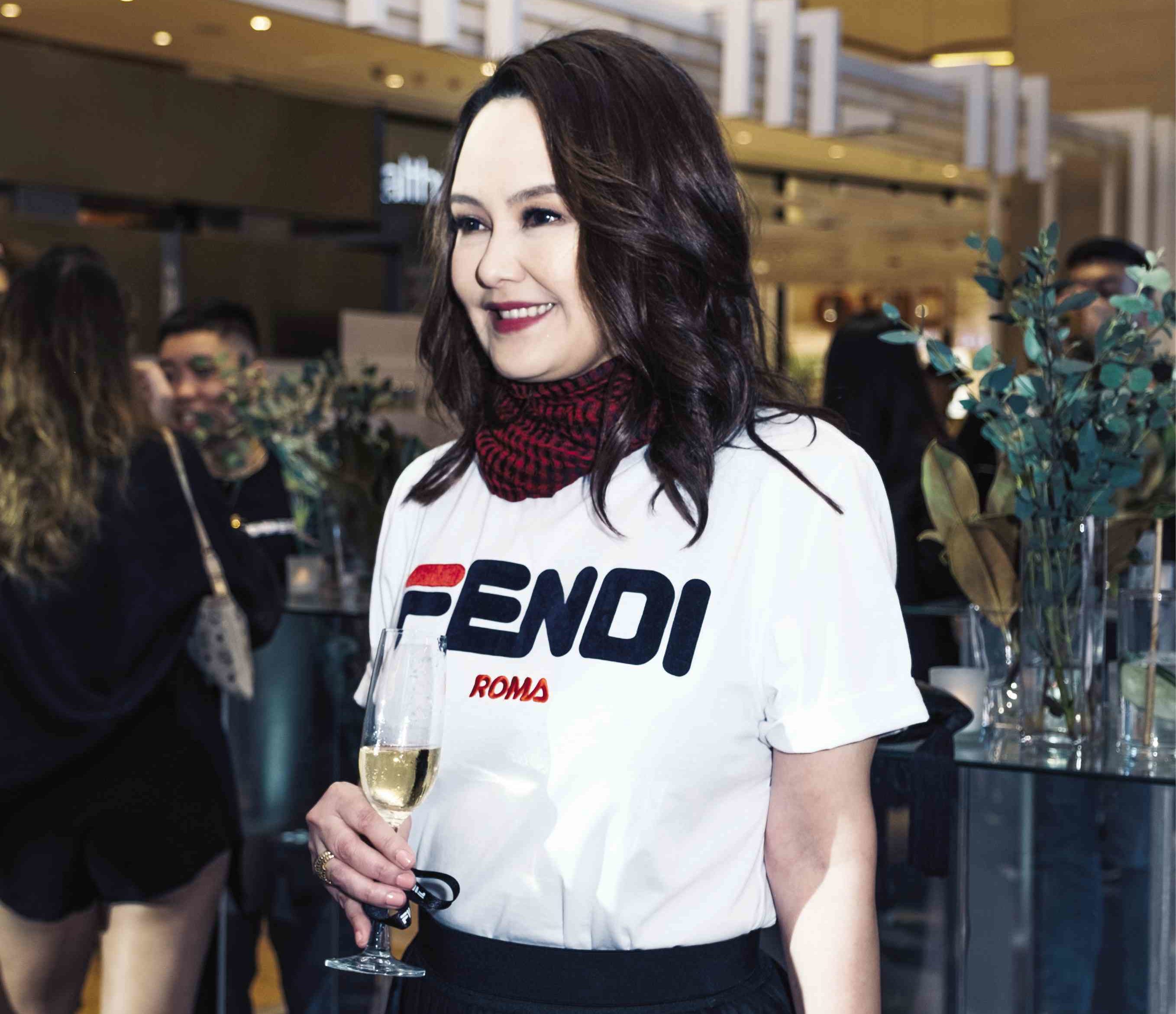
Maricris Albert wears a Fila X Fendi, another successful collaboration with the luxury Italian brand. —CONTRIBUTED PHOTO
Once known chiefly as cut-rate athletic footwear, Fila has evolved into a fashion trailblazer. Collaborations with famous brands and designers efficiently rebooted the 108-year-old trademark. Simultaneously, Fila capitalized on the retro movement by releasing its vintage styles, thus reconnecting with old customers and strategically developing new markets.
The label is better known in the country for lifestyle sportswear and sneakers than performance (tennis, basketball) footwear. In any case, while most others in the industry focus on brand awareness, Fila Philippines relies on sales-driven objectives supported by savvy price structures.
Maricris Albert, Fila Philippines president and CEO, notes that the brand is consistently competitive in the C market on account of its affordable MIC (made-in-China) styles.
Fila is a global licensing brand from Italy. Every country, where it is found, is free to design and adapt styles according to market preferences. The latest products available locally are made in China and use inexpensive materials so they can be sold from P1,499 to P2,499.
Tapping the A crowd
One of the brand’s recent successes is the “Heritage” line, which has grown significantly since worldwide fashion started waxing nostalgic. Fila Heritage revives archival styles popular in the late 20th century.
A customized version, Albert says, uses semi-aniline (pigmented) leather and polyurethane (quality plastic) as substitute for real hundred-percent leather.
“The C market made us what we are today,” she elaborates. “These customers are attracted to brightly lit stores where they can come in at their most casual, maybe even wearing slippers. We knew they’d want the current designs, so we improvised on the materials.”
With the opening late last year of the high-end Fila Italia in Uptown Mall, Bonifacio Global City, Fila Philippines is tapping the AB market. The 120-square meter boutique offers footwear and apparel from the United States, Japan and Korea. In the first month, it made P6 million in sales from an emerging upper-class clientele that is rediscovering the brand but are used to quality materials. They are willing to spend P3,499 to P4,999 for a pair as long as the styles come in limited editions.
In fact, with the current trend in bulky sneakers—popularized by Fila in the ’80s and ’90s—the AB market snaps up premium styles, such as the Disruptor Made In Italy, priced at P14,999.
Double-digit growth
“Fila’s game plan is to fulfill the needs of all markets while staying aligned with the global strategies,” Albert points out.
At the other end of the customer scale is the cost-sensitive D bracket, which tends to make purchases only when prices are slashed. The “Green” stores, literally color-coded depots, carry styles at sale prices, from P499 to P699.
The company recently marked a double-digit growth compared to the same period last year. She attributes this to organic sales, increased stock delivery, efficient distribution, business development and store segmentation.
Fila is the top-selling brand in the online fashion shopping network Zalora. Its own e-commerce is further propelled by influencers, online raffles and discounts. Buzz in social media is also created with product drops, a trend that entails a special release of products that will only be available for a limited time or quantity.
Cool collaboration
The frequent collaborations to explore new horizons are meant to refresh its century-old image. Worth mentioning is the one with Brazilian footwear brand Melissa: the resulting Brazilian slides carry Fila’s logo and signature colors. The average price for a pair of Fila X Melissa slides is P3,999, creating a distinctive market of savvy women over 25 years old.
“Melissa wants to be cool and penetrate the streetwear crowd,” Albert explains. “It is also helpful for people to know that Fila makes women’s slides. This line is doing well.”
Fila Philippines holds special events to create new customer experiences. One of the latest was conducted in partnership with Gelato, which offered free ice cream at select stores. Ice cream colors matched those of the footwear, the better to tell a new—fun—brand story.
Collaborators, whether for production or promotions, are brands that “share the qualities” of Fila merchandise,” Albert stresses.
Keeping it fresh
Another factor in Fila’s resurgent popularity, she says, is what has come to be known as the “athleisure” trend. “People buy running or tennis shoes for everyday wear; they just want to look sporty.”
Despite being a heritage brand, Fila manages to keep a “fresh” image in the Philippines. Another marketing strategy that Albert reveals might explain this. A recent usage, attitude and image research revealed that consumers always find new products on the shelves. Heeding this, Albert keeps the styles moving. “If a product doesn’t sell in the AB store, it goes to the depot so that our market there will see something new.”
When Disruptor 2 was named 2018 Shoe of the Year last October at the Footwear News Achievement Awards (dubbed “The Shoe Oscars” and held annually in New York City since 1986), Albert ordered 2,000 pairs. With a price point of $70 (approximately P3,640), they easily sold out.
Albert reports, “Our next order will be in a different color—except for the white Disruptor because the demand [for that one] is strong.”
Next up: apparel
She sees apparel, particularly shirts and jackets, as the next area for growth.
Fila Philippines has 440 stores nationwide, with an extensive reach in the Visayas and Mindanao that rivals other global sports brands. Of these, 100 are stand-alone operations closely monitored at the head office in Makati. The rest are inside department stores.
“My dream is to get every Filipino to wear a Fila,” Albert says. —CONTRIBUTED

